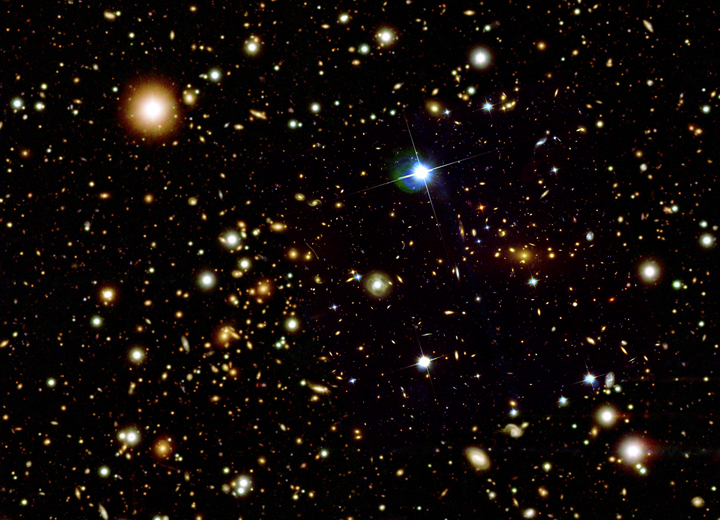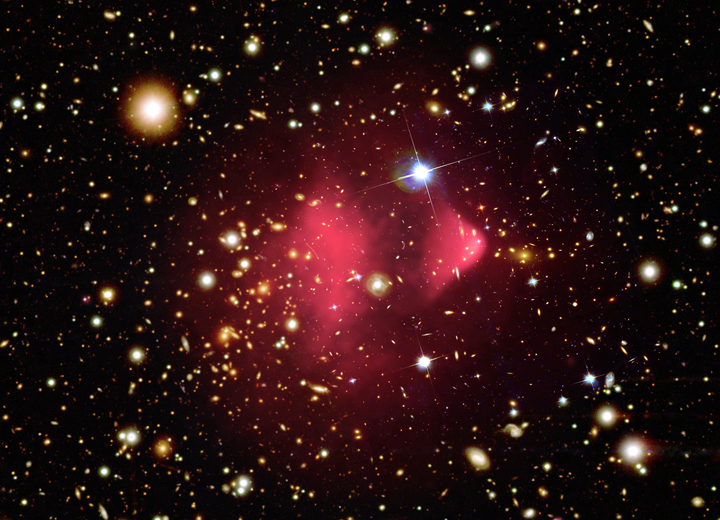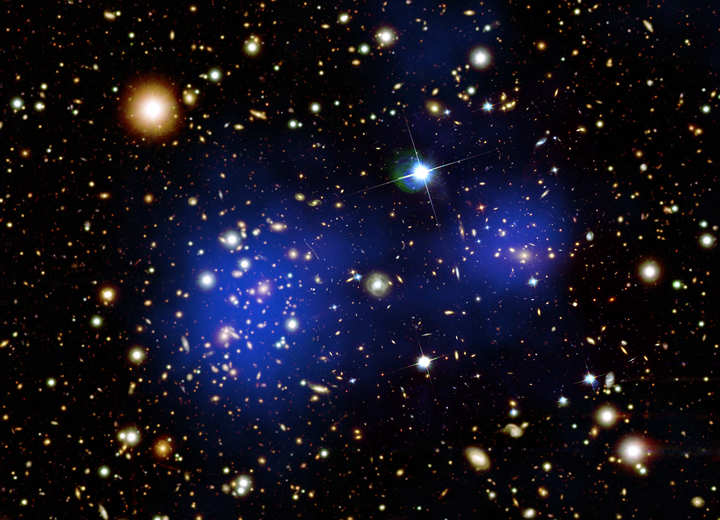The universe from a lightcone centered in Mexico. Astronomy, physics, science and math sprinkled with some humor and mundane stuff.
Thursday, August 24, 2006
Au revoir Pluto!
This was the correct decision (so we finally admit there was a mistake made more than 70 years ago) but I was surprised when the news arrived on tuesday that most astronomers not only wouldn't vote the proposed definition but actually wanted Pluto out of town. I definitely didn't expected that the IAU would demote Pluto as a planet, mostly because astronomers have always been very much conservative, take the horrible magnitude system as an example (we have a very ugly system for measuring fluxes that was made only to agree with some measurements done in the classic Greece!).
On the other side the decision to call Pluto a member of a new class of planets, the plutons, instead of just calling it a planetoid is silly and was fortunately rejected so Pluto is now a "minor planet". The obvious name for this kind of objects is planetoids and everyone out there is using it but somehow the IAU doesn't thinks that, but well... what can I do on that regard?
Monday, August 21, 2006
The Smoking Gun

This is the Bullet Cluster at optical wavelenghts, the bunch of galaxies in the upper right form one of the two interacting subclusters, in the bottom left corner you can the second (and smaller) interacting cluster.
The concept of dark matter isn't really that new, it was proposed by Fritz Zwicky in 1933 who realized from observations of the Coma Cluster that the speeds of the galaxies in the cluster were too high to keep the cluster bounded, he realized the mass of the cluster should be 400 times greater to keep it together and although later observations showed some of this mass there was still less than the required to explain the motions of the galaxies. We have now evidence in many clusters, also the mass infered from gravitational lensing is always bigger than the mass from the observed galaxies, even in our own milky way the stars in the outer regions of the spiral disk orbit at higher velocities than we should expect from the observed mass.
There are two straightforward ways to explain this observations:
- There is more mass than we observe, this can be because it cames in the form of cold objects than don't emit much light (like the funny named MACHOs and brown dwarfs) or from some kind of matter that interacts very weakly with "normal" (baryonic) matter (these are called WIMPS, an obvious and funny match for the rival of baryonic matter). The latter explanation is much favored because the MACHOs and brown dwarfs seem to contribute only a small fraction of the missing mass.
- We need to modify the laws of gravity, a particular popular model of this type involves a modification of inverse square depence of gravity and is called MOND. Despite its problems in explaining some observations regarding gravitational lensing it was (until this morning) a more or less viable explanantion.
After observations with the Chandra X Ray Telescope Markevitch et al (1,2) it was possible to observe the gas component of the cluster (in clusters of galaxies most of the mass -around 90%- is in the form of a very hot gas that emits x rays) and it showed clear evidence of a recent interaction between the two clusters. This collision heated the gas even more, as far as I know this is the hottest known cluster.
 The Bullet Cluster in x rays is shown in the pink zone of the picture. Two shock front on the right corresponds to the smaller cluster, this front has the highest mach number of all the known intergalactic medium
The Bullet Cluster in x rays is shown in the pink zone of the picture. Two shock front on the right corresponds to the smaller cluster, this front has the highest mach number of all the known intergalactic medium
The most interesting part comes now, the galaxies in the clusters actually don't crash and rather pass by without changing that much, but the remaining matter in the gas forms about 90% of the mass of the cluster and we can use the x ray observations to see if the source of gravity points in the same direction where most of the observable mass is located. What makes the Bullet Cluster so special is that the galactic component is separated from the gas element, as dark matter (by definition) interacts very weakly if it interacts at all it will be in a position similar to the galactic component that passes almost unperturbed the interaction.
But how can we know where gravity comes from? One of the most surprising predictions of Einstein's theory of general relativty is that gravity can bent light in the so called gravitational lenses, the paper by Clowe et al (3) shows the weak lensing map of the bullet cluster maping the location of the mass in the cluster.
 The blue part of the picture maps the position of the matter causing the weak lensing in the background galaxies. As it turns out it is a map of the dark matter of the cluster!
The blue part of the picture maps the position of the matter causing the weak lensing in the background galaxies. As it turns out it is a map of the dark matter of the cluster!
Now, if you expect that the laws of gravity should be modified to explain the rotation curves in galaxies and the motions of galaxies inside clusters then you should expect at least that the weak lensing map points in the same direction of the observed matter, after all it's gravity should produce the weak lenses. It turns out that both the weak lensing and xray maps are well separated with the weak lensing map in the same position of the galactic component just as expected from dark matter!

This image shows the x ray emission in pink and the position of the mass causing the weak lenses in blue, as you can see most of the mass of the cluster is not in the observed xray emission and is actually just in front of the observed galaxies clearly showing that it has not interacted with the hot gas component. If this is not convincing enough for you then anything will be.
This shows conclusively that most of the matter in the Bullet Cluster is not in the observed x ray emission (and much less in the observed galaxies) but in an "invisible" component that only manifests through its gravitational presence. You can see here an animation of how we think this process happened. There is simply no way to fit any alternative theory of gravitation in it, the principal source of gravitational mass is simply not observed in any light wavelenght. Regarding the composition of dark matter this is one of the biggest unsolved problems in astronomy and physics, my personal guess is that is composed mostly of axions and light supersymmetric particles (the lightest supersymmetric partner turns out to interact really weaky and is stable as it can't decay into a lighter particle), but again it's just my guess.
Images courtesy of NASA, you can see more images here.
Thursday, August 17, 2006
What a week !!!
Actually this is not a redefinition of the planet concept, the truth is that we have never had a definition at all! The reason is that of the current nine accepted planets six were known since prehistoric times (when people used FORTRAN and hunted woolly mammooths) because they are easy noticeable in the sky (changing it's position everyday and not blinking as stars). When W. Herschel discovered Neptune and the posterior finding of Uranus (which was predicted by theoretical calculations!!!) it was clear that they were very similar to the known planets so there wasn't much contreversy.
Using the same theoretical arguments it was expected that a ninth planet would eventually emerge and Clyde Tombaugh eventually "found" it at Lowell Observatory in 1930. It was only decades later when it's "moon" Charon was found and it became possible to approximate Pluto's mass, this mass is so small that it has a negligible effect on the orbits of the other planets (another interesting feature of the Pluto-Charon system is that the center of gravity of this system is outside of Pluto, so both orbit a common center somewhere between them) so the question remained open and the existence of a "Planet X" was expected (at least by a few astronomers). Today we know that the data used for the "theoretical" prediction of Pluto was simply wrong and there is nothing as a "Planet X", although high precission measure of the orbits of the probes Pioneer 10 and 11 seem to point to some source of perturbation a major planet is not in the possible explanantions.
Recently the problem of defining a planet has emerged from two principal sources:
- The extrasolar planets found using diverse techniques seem to be way more massive than Jupiter (the most massive planet in the solar system) and some of this planets were found so close to it's star that it challenged the model of planet formation of that time and it's still a bit problematic. It was hard to know where planets end and stars begin.
This has generated much controversy about what is a planet, as our current list of planets seems to include an object that is esentially a big asteroid (Pluto) and some really big extrasolar planets that are almost stars. So the IAU has proposed the following definition:
A planet is a celestial body that (a) has sufficient mass for its self-gravity to overcome rigid body forces so that it assumes a hydrostatic equilibrium (nearly round) shape, and (b) is in orbit around a star, and is neither a star nor a satellite of a planet.
Using this definition the solar system would increase inmediately to 12 (planetary) members, and the new folks in town will be: Ceres, Charon (so the Pluto-Charon system would be considered a double planet) and Xena. There are other obvious candidates like Quoar that would enter the planet definition as soon as astronomers confirm their properties. The definition also includes a new class of planet: pluton that applies to all planets similar to (ughh) Pluto.

These are the "new" planets, one of them (Ceres) has been considered for long time as an asteroid of the asteroid belt between Mars and Jupiter.
In my personal opinion this "new" definition is nonsense, despite it is based on a scientific and unambigous definition it simply adopts a "leave no big icy rock behind" and this "new" solar system is way too messy (specially for the public, after all the definition isn't really that much relevant for astronomers), the solar system will have eventually hundreds of planets that have little (if any) in common like Ceres and Jupiter. Not only that, this definition is completely ambigous on the other end of the spectrum and leaves the separation between brown dwarfs and big planets as blurry as it can be. It is expected that the resolution will be decided on August 24th. Many of my peers are in Prague waiting impatiently the result of this resolution, I will inform you about it as soon as I can.
 Look at some of the new candidates for planets, all them are very small, actually some of the moons of Jupiter and Saturn have the double (or more) of its size. Just compare the size of Vesta and Pallas (in the asteroid belt) with the size of the earth.
Look at some of the new candidates for planets, all them are very small, actually some of the moons of Jupiter and Saturn have the double (or more) of its size. Just compare the size of Vesta and Pallas (in the asteroid belt) with the size of the earth.